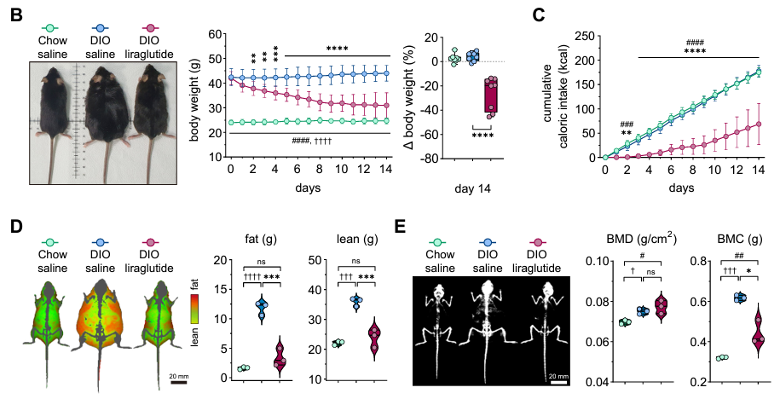System Used:
iNSiGHT

M-Series
M-Series
Obesity has emerged as a critical research topic due to its profound impact on public health and well-being. The rising prevalence of obesity worldwide has led to a significant burden on individuals, communities, and healthcare systems. By shedding light on the complexities of obesity, researchers strive to develop effective strategies to prevent and manage this global health crisis.
Obesity is linked to numerous health complications, including cardiovascular diseases, type 2 diabetes, certain types of cancer, musculoskeletal disorders, and mental health conditions. Moreover, obesity is associated with reduced quality of life, increased healthcare costs, and decreased life expectancy. Recognizing these detrimental effects, researchers have intensified their efforts to unravel the underlying causes and develop effective prevention and treatment strategies.
Liraglutide, and other glucagon-like peptide-1 (GLP-1) agonists, have shown significant efficacy as anti-diabetic and anti-obesity drugs, currently marketed under the names Ozempic®, Victoza®, and Saxenda®. While the metabolic effects of liraglutide and semaglutide are well established, their specific impact on various tissues remains largely unexplored.
In this paper Park et al. study the metabolic profiles induced by liraglutide in diet-induced obese mice. By employing comprehensive metabolomic analyses of the hypothalamus, plasma, liver, and skeletal muscle, the study aims to uncover the diverse metabolic alterations brought about by liraglutide treatment. The iNSiGHT DXA system was used in this study not only to monitor changes in both lean and fat mass over time, but also to look at the bone mineral content and density through the course of this study.
GLP-1, an incretin hormone, plays a crucial role in insulin secretion, glucagon suppression, and appetite regulation through the GLP-1 receptor (GLP-1R). Liraglutide, a long-acting GLP-1 analog, has gained significant popularity in the treatment of type 2 diabetes and obesity due to its extended half-life and therapeutic benefits. Liraglutide exerts its effects by suppressing appetite, reducing body fat and inflammation, regulating blood glucose levels, and promoting thermogenesis and browning of adipose tissue.
The study conducted metabolomic analyses to investigate the effects of liraglutide on the metabolism of various tissues. The results revealed significant metabolic alterations induced by liraglutide treatment in comparison to diet-induced obese or nonobese mice. Notably, liraglutide exhibited coordination of fatty acid metabolism in the hypothalamus and skeletal muscle, as well as amino acid and carbohydrate metabolism in plasma and liver.
Comparative analyses of metabolite dynamics highlighted that liraglutide treatment rewired inter-tissue metabolic correlations. These findings suggest that liraglutide exerts its therapeutic effects by influencing metabolic pathways in multiple tissues and potentially facilitating communication and coordination between them.
Metabolomics, a powerful approach in surrogate diagnostics, plays a crucial role in identifying biomarkers and elucidating mechanisms underlying metabolic disorders such as diabetes and obesity. By employing metabolomics, researchers gain insights into the efficacy of anti-diabetes and anti-obesity therapeutics. While previous studies have explored the effects of other medications using metabolomics, this study provides novel insights into the metabolic alterations induced by liraglutide treatment.
The study underscores the importance of investigating the metabolic alterations induced by liraglutide, a potent GLP-1 analog used in the management of type 2 diabetes and obesity. By employing comprehensive metabolomic analyses, researchers revealed significant changes in metabolic profiles in various tissues following liraglutide treatment. These findings enhance our understanding of the therapeutic effects of liraglutide and its impact on inter-tissue metabolic coordination. Further research in this area may lead to the development of more targeted and effective therapeutic interventions for individuals with type 2 diabetes and obesity.

